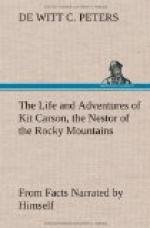“’Around us, the whole scene had one main striking feature, which was that of terrible convulsion. Parallel to its length, the ridge was split into chasms and fissures, between which rose the thin, lofty walls, terminated with slender minarets and columns, which are correctly represented in the view from the camp on Island Lake. According to the barometer, the little crest of the wall on which we stood was three thousand five hundred and seventy feet above that place, and two thousand seven hundred and eighty above the little lakes at the bottom, immediately at our feet. Our camp at the Two Hills (an astronomical station) bore south 3 deg. east, which, with a bearing afterward obtained from a fixed position, enabled us to locate the peak. The bearing of the Trois Tetons was north 50 deg. west, and the direction of the central ridge of the Wind River Mountains south 39 deg. east. The summit rock was gneiss, succeeded by sienitic gneiss. Sienite and feldspar succeeded in our descent to the snow line, where we found a feldspathic granite. I had remarked that the noise produced by the explosion of our pistols had the usual degree of loudness, but was not in the least prolonged, expiring almost instantaneously. Having now made what observations our means afforded, we proceeded to descend. We had accomplished an object of laudable ambition, and beyond the strict order of our instructions. We had climbed the loftiest peak of the Rocky Mountains, and looked down upon the snow a thousand feet below, and, standing where never human foot had stood before, felt the exultation of first explorers. It was about two o’clock when we left the summit; and when we reached the bottom, the sun had already sunk behind the wall, and the day was drawing to a close. It would have been pleasant to have lingered here and on the summit longer; but we hurried away as rapidly as the ground would permit, for it was an object to regain our party as soon as possible, not knowing what accident the next hour might bring forth.’”
This peak was found, by barometrical observation, to be thirteen thousand five hundred and seventy feet above the waters of the Gulf of Mexico. It bears the name of the Great Explorer, being called Fremont’s Peak.
The return trip was now commenced, all of the objects of the expedition having been successfully accomplished. The party again reached Fort Laramie in the month of September, 1842. Kit Carson had served in the double capacity as a hunter and guide. It is sufficient to say of the manner in which he performed his duties that he won the friendship of John C. Fremont, and has ever occupied since then a prominent and permanent place in his esteem. At Laramie, Kit Carson’s labors were done. There he bid his commander good bye and set out for New Mexico. Fremont returned to the United States in safety. Thus terminated the first of his great explorations.
Kit Carson’s Indian wife had long since been dead. In the month of February, 1843, he married a Mexican lady by the name of Senora Josepha Jarimilla. Of this lady it is sufficient to say that for her many virtues and personal beauty she is justly esteemed by a large circle of acquaintance. By this wife Kit Carson has three children, to whom he is devotedly attached.




